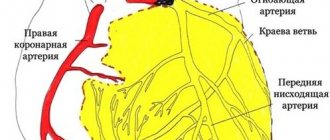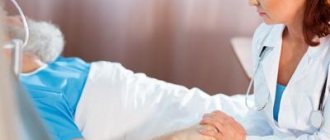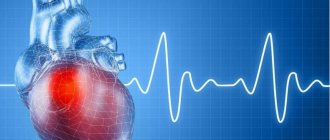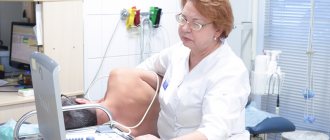Vegetovascular dystonia is a pathological condition in which the functioning of the autonomic nervous system is disrupted. Patients with this syndrome are often diagnosed with changes in the cardiovascular system, which is manifested, among other things, by periodic attacks of tachycardia. The patient's heart rate increases to 90 beats per minute or more, weakness and dizziness, a feeling of fear and anxiety also occur. However, in most cases, all symptoms disappear before the doctors arrive, and they disappear as suddenly as they begin. Treatment is based on maintaining a healthy lifestyle, monitoring the patient’s psychological state, and periodically taking medications.
Physiological aspects of vegetative-vascular dystonia
Vegetovascular dystonia is a common diagnosis. Normally, the heart works as an autonomous mechanism, constantly providing blood flow through the vessels. The frequency, strength and rhythm of heart contractions are regulated by the myocardial conduction system, endocrine glands and the autonomic nervous system. Together, these mechanisms ensure proper functioning of the heart muscle both at rest and during physical activity.
The autonomic nervous system is divided into sympathetic and parasympathetic divisions. When the first one is excited, the pulse rate increases, while the second one decreases. Tachycardia with VSD is associated with excessive activation of the sympathetic nervous system and at the same time inhibition of the parasympathetic, resulting in an imbalance.
REFERENCE! The work of the heart is also influenced by external factors. Thus, under conditions of hypoxia and after exercise, a slight acceleration of the heart rate is considered normal. Tachycardia, which needs to be eliminated with medication, is indicated by a rapid, up to 90 beats per minute, pulse in a state of complete rest.
2. Causes of the disease
The following factors are considered to be the causes of paroxysmal tachycardia:
- endocrine disorders;
- transient oxygen starvation of the heart muscle;
- changes in the concentration of electrolytes in the blood;
- heart defects;
- inflammatory diseases of the heart muscle;
- hypertension;
- hereditary factor;
- psycho-emotional factor.
However, in some patients no obvious causes are identified either before the onset of an attack or during life.
Visit our Cardiology page
Tachycardia - definition and classification
Tachycardia is an increase in heart rate. Normally, this figure is 60-90 beats per minute, but can vary depending on many factors. So, a tall person or someone who is overweight needs more oxygen and nutrients, so the heart will beat faster. Also, the pulse increases after intense exercise and during the hot season, in rooms with insufficient ventilation. Pathological tachycardia is considered to be an increase in heart rate for no apparent reason, which is accompanied by additional symptoms.
There are several classifications of tachycardia with VSD. The first of them identifies several varieties of the syndrome depending on the cause of its occurrence:
- intracardial - develops as a result of cardiac dysfunction;
- extracardiac - rapid pulse is a symptom of pathologies not directly related to the work of the heart.
It is also necessary to distinguish between the main types of tachycardia depending on the location of the focus in which the impulse occurs:
- paroxysmal (ectopic) - can be ventricular, if the impulse originates in the ventricles, or supraventricular, if it originates in the atria;
- sinus - the impulse comes directly from the sinus node.
With vegetative-vascular dystonia, extracardiac tachycardia is characteristic, that is, an acceleration of the pulse does not indicate pathologies of the cardiovascular system. There are also several variants of manifestation of this syndrome:
- single attacks, in which the pulse rate can reach up to 120-240 beats per minute, but the indicators quickly normalize;
- constant tachycardia - at rest, the heart rate per minute is 90-120 beats, and symptoms may remain unnoticed for a long time;
- sinus - frequent increase in heart rate to 120-130 beats per minute.
If untreated, tachycardia with VSD is dangerous, despite the fact that there is no organic damage to the heart. An increase in the load on the myocardium over time can lead to progressive hypoxia (coronary heart disease), and also cause a heart attack or stroke.
When the heart rate increases, panic attacks often occur, but it is worth remembering that even significant tachycardia caused by VSD is safe for health
Paroxysmal tachycardia or panic attacks?
Anastasia, St. Petersburg
February 14, 2021
Hello. I would like to know the opinion of doctors. I suffer from attacks of palpitations. They started a long time ago, about 6 years ago. Occurs once a year (once there were two months in a row once). The attack begins with a feeling of dizziness, my legs leave the ground and I notice how my heart is in my chest like a motor. The feeling is that it will simply stop now from such a volley. It gets dark in the eyes, the whole body is buzzing and it’s hard to breathe. Nothing hurts though. After the first attack, they called an ambulance; when it arrived, the attack had already subsided. They did an ecg and said that everything was fine, just from nerves and diagnosed VSD. The only thing is that the paramedic said that my heart was really pounding and suggested that my pulse was over 200. I was advised to carry anaprilin with me and take it during attacks. I continued to live and didn’t worry about it. After that, there were attacks three more times (once a year). But more than a year ago something strong happened, not like the others. They called an ambulance for me too. I felt bad, my heart tumbled in my chest (it felt like quick, quick tremors, like a machine gun) and again my heart was beating wildly, I was already mentally saying goodbye. A month later the attack repeated, only without the tremors at first. I began to be very afraid, I began to have constant tremors in my heart (especially after exercise). They existed before, but rarely and did not bother me. When I came to the appointment and told everything, I was initially diagnosed with atrial fibrillation and was told that I needed to have a holter. He was caught in a paroxysm of supraventricular tachycardia and extrasystoles. (Although this attack was not like that. It happened when I changed my lying position and was like quick tremors. As soon as I assumed a vertical position, it disappeared). A diagnosis of paroxysmal supraventricular tachycardia was made. I was prescribed Concor Cor 2.5. I took it for over a year and felt good. There were interruptions, but they were not frequent. I decided to make a halter and it was perfect. I contacted the doctor and decided to reduce the dosage to 1.25 (although the doctor insisted on leaving everything as it was and warned that the pure Holter was due to the drug). But I decided to try and two weeks later I had an attack. I climbed the stairs to the 5th floor and sat down. After sitting for about three minutes, I felt my heart pounding wildly. I was wearing a watch that would measure my pulse. They showed that the pulse was 161 (this is most likely climbing the stairs) and at the moment it was 128, a second later it showed 133 and another moment later it was 145. (It felt like more than 145). I took anaprilin and asked to lie down. They measured my blood pressure - 160 over 90. After 3 minutes it was 145 over 100. Then it went away. In general, the attack lasted about 6 minutes (I never had it for longer than 10 minutes). After that I felt terrible for two hours. Weakness, my legs hurt and were wobbly, my ears were blocked. I decided to do an ECG and it wasn’t very good. First. Now I'm wildly afraid to even go outside. I would like to ask if these attacks are similar to paroxysmal tachycardia? Or is it panic attacks, neurosis? Should I take Concor? Is it possible to take it at a dosage of 2.5 on a regular basis? (I’m worried that I’m only 25 and what will happen next if I’m already taking a serious drug). And can such attacks be caused by the thyroid gland? (In childhood, they diagnosed a non-toxic goiter, but after those two attacks, TSH was at zero, T3 and T4 were elevated. They diagnosed thyrotoxicosis. (Although I don’t have a goiter, it is slightly enlarged). It went away in a couple of months, I didn’t take any medications. Now TSH at level 3. Autoimmune is not diagnosed, although there were suggestions). My pulse has always been high. 90-100. I am attaching the conclusions of a bad Holter, heart ultrasound and ECG after the attack. Thank you.
The question is closed
arrhythmia
tachycardia
panic attacks
paroxysmal tachycardia.
Causes of increased heart rate with VSD
Patients with vegetative-vascular dystonia periodically suffer from pulse and blood pressure disturbances. These attacks can be spontaneous, but in most cases they can be predicted in advance. So, tachycardia can be provoked by the following changes:
- sudden changes in weather conditions, including in the off-season;
- eating large amounts of food;
- intense physical activity, as well as sudden movements and changes in body position;
- violation of the diet (instant coffee, alcoholic and carbonated drinks are especially dangerous);
- any stressful situations.
A healthy lifestyle and a stable psychological state are the main conditions for preventing another attack. However, increased concern for one’s own health can cause the development of cardioneurosis. In this condition, the patient constantly listens to the rhythm of the heart, counts the pulse and measures the pressure, which can activate the next exacerbation.
Treatment
- Emergency care for paroxysmal tachycardia. There are a number of ways to reflexively slow down the rhythm, the so-called vagal tests, which the cardiologist teaches the patient. An urgent call for a cardiac emergency medical team is urgent.
- Conservative therapy . Performed by experienced cardiologists. Individual selection of medications to relieve paroxysmal tachycardia and prevent attacks, as well as to reduce the risk of thrombosis, improve myocardial condition, etc.
- Surgery . Depending on the patient’s condition and the nature of the attacks, various interventions are used: radiofrequency ablation of arrhythmogenic zones or implantation of a cardioverter-defibrillator.
At the Yauza Clinical Hospital, the decision on surgical intervention, its choice and the operation itself are carried out by cardiac surgeon-arrhythmologist Professor A.V. Ardashev. The cardiology department of our hospital carries out dynamic monitoring of patients with paroxysmal tachycardia and timely correction of their treatment, reducing the risk of dangerous conditions and complications.
Cost of services
Make an appointment
You can see prices for services
Signs of an attack
Normally, a person does not feel the work of the heart. When the first symptoms of tachycardia appear, the patient’s pulse quickens, as if after running or with strong excitement. There is also a feeling of fear and anxiety, which is largely provoked by the presence of additional symptoms. Despite the fact that tachycardia with VSD is not a life-threatening condition, it often becomes a reason to call doctors. The patient is concerned about the following signs:
- severe weakness;
- frequent and strong heartbeat;
- pain in the chest area, which raises suspicion of myocardial infarction;
- heavy breathing, shortness of breath;
- headache and dizziness;
- panic attacks, which further aggravate the clinical picture.
The most common type of syndrome is sinus tachycardia. It is characterized by an increase in the excitability of the sinus node, as a result of which the heart rate increases to 120-130 beats per minute. This clinical picture can develop at any age and is not a cause for concern if it is not accompanied by additional signs.
REFERENCE! Sinus tachycardia, which most often occurs with VSD, does not cause heart rhythm disturbances. Any manifestations of arrhythmia indicate the need for additional diagnostics of the condition of the heart and blood vessels.
Necessary examinations
If an attack of tachycardia occurs for the first time, a complete diagnosis of the cardiovascular system is indicated. An increased heart rate also causes additional symptoms that need to be taken into account. The patient’s condition can be assessed using a series of studies:
- electrocardiography is one of the main methods for diagnosing myocardial function;
- echocardiography - examination of the condition of the heart using ultrasound;
- if necessary, tonometry using MRI.
VSD is identified as an independent disease. It was placed in a separate category in the ICD-10 classification. Heart rate disturbances caused by a deficiency of the autonomic nervous system do not pose a threat to the patient's life. A set of examinations that are offered after the first attack, as well as to monitor the condition of the heart and blood vessels, do not show any serious abnormalities.








